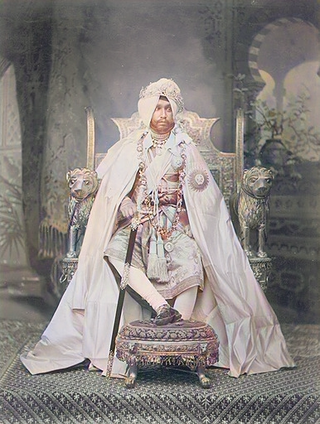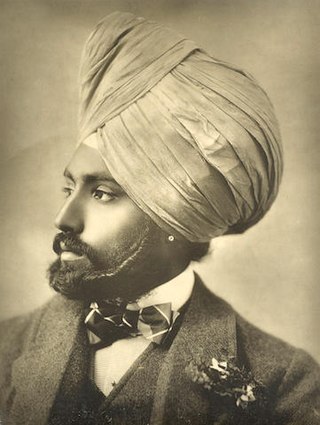
Chand Kaur was the regent of the Sikh Empire, proclaimed as Malika Muqaddisa on 2 December 1840. She was born to Sardar Jaimal Singh of the Kanhaiya Misl. In 1812, she was married to Crown Prince Kharak Singh, son and heir apparent of Maharaja Ranjit Singh and Maharani Datar Kaur. In 1821 she gave birth to their only son Nau Nihal Singh, who became second in line of succession to the throne of Punjab.
Mata Nihal Kaur, popularly known as Mata Natti, also known as Ananti, Nihalo, and Bassi, was the wife of Baba Gurditta.

The Maharaja of Patiala was the title of the ruler of the princely state of Patiala, in British India. The first ruler of Patiala was Baba Ala Singh, who held the title of Raja. The second and third rulers, Amar Singh and Sahib Singh, respectively, held the held the title of Raja-e-Rajgan. Karam Singh, the fourth ruler, was the first ruler of Patiala who held the title of Maharaja. By the time of the seventh Maharaja, Rajinder Singh, the Maharaja of Patiala was recognized as the leader of the Sikh community and the most foremost prince in Punjab. During the British Raj, the Patiala maharajas were entitled to a 17-gun salute and had precedence over all the other princes in Punjab.
The principles of Sikhism state that women have the same souls as men and thus possess an equal right to cultivate their spirituality with equal chances of achieving salvation. Women participate in all Sikh religious, cultural, social, and secular activities including lead religious congregations, take part in the Akhand Path, perform Kirtan, perform Gatka and work as a Granthis.
Barnala is a city in the state of Punjab of India. Barnala city serves as the headquarters of the Barnala district which was formed in 2006. Prior to formation of Barnala district, this city was located in Sangrur district. It is a centrally located district bordered by Ludhiana district on the north, Moga district on northwest, Bathinda district on west, Sangrur district on east and Mansa district on south side.
Bhadaur is a town in Barnala district in the state of Punjab, India. It is part of the Bhadaur Assembly Constituency.
Jandiala is a village of the Jalandhar district situated in the Indian state of Punjab, in India.
Bibi Sahib Kaur (1771–1801) was a Sikh princess and elder sister of Raja Sahib Singh Sidhu of Patiala.

Preneet Kaur is an Indian politician who served in the Government of India as a Minister of State in the Ministry of External Affairs from 2009 to 2014. She is married to Amarinder Singh, who was the 15th Chief Minister of Punjab. She joined the Congress party, to which her husband also belonged once, and contested parliamentary elections repeatedly from the Patiala constituency. In February 2023, she was suspended from the party for supporting BJP leader and her husband Amarinder Singh and campaigning for candidates of the BJP or BJP-allied parties. She won the elections of 1999, 2004 and 2009, but lost her seat in the elections of 2014 and made a comeback by winning again in 2019.

Bibi Bhani, also known as Mata Bhani, was the daughter of Guru Amar Das, the third Sikh Guru. She played a central role in the history of Sikhism and is one of the four consorts bestowed with the title of Guru-Mahal.

Sir Rajinder Singh was the Maharaja of the princely state of Patiala from 1876 to 1900. During his reign, Singh was noted for his military service, extravagant spending habits, tense relations with the British Raj, marriage to an Irish woman named Florence Bryan, and his contributions to sports both as a player and as a financial benefactor. Singh was regarded as the leader of the Sikh community and the premier Maharaja in Punjab.

Dalip Kaur Tiwana was one of the foremost novelists and short-story writers of contemporary Punjabi literature. She won awards, both regional and national, and was a widely translated author. She retired as Professor of Punjabi, and Dean, from Punjabi University, Patiala. She is widely credited as a tour-de-force in the creation of the contemporary literature in the Punjabi language.

Brigadier Maharajah Sir Ranbir Singh G.C.S.I., G.C.I.E. was the Maharaja of Jind. He ruled Jind from 1887 to 1948- one of the longest terms as the ruler.

The Nakai Misl, founded by Sandhu Jats, was one of the twelve Sikh Misls that later became part of the Sikh Empire. It held territory between the Ravi and Sutlej rivers southwest of Lahore in what became Pakistan. The misl fought against the Sials, the Pathans and the Kharals before it was incorporated into the Sikh Empire of the Sukerchakia Misl by Ranjit Singh.

Patiala State was a kingdom and princely state in British India, and one of the Phulkian States, that acceded to the Union of India upon Indian independence and partition in 1947. The state was founded by Ala Singh in 1762. Patiala State was the largest and most important princely state in the Punjab Province. The state's ruler, the Maharaja of Patiala, was entitled to a 17-gun salute and held precedence over all other princes in the Punjab Province during the British Raj. The state was ruled by Jat Sikhs of the Sidhu gotra (clan).

Ala Singh (1691–1765) was the founder and first ruler of the princely state of Patiala. Singh was born into the Sikh Phulkian dynasty, which had an ancient lineage, being direct descendants of Rawal Jaisal Singh, the founder and ruler of the Kingdom of Jaisalmer in the 12th century, and further back to Rao Bhatti, a Hindu king in the 3rd century. Rising to power through key battles in his early life, Singh expanded his territory in Punjab.
Sardar Ran Singh Nakai was the third chief of the Nakai Misl, which was one of the Sikh groupings and guerilla militia that later became part of the Sikh Empire. He was born to the Sandhu family of Jat Sikhs. He distinguished himself at an early age in campaigns with his father, Natha Singh Sandhu and uncle, the legendary Heera Singh Sandhu who was the founder of the Misl. Ran Singh was a fierce warrior and a powerful misldar; under his leadership the misl was at its highest. He was the father of Maharani Datar Kaur and the father-in-law of Maharaja Ranjit Singh, the founder of the Sikh Empire. He was the grandfather of Maharaja Kharak Singh, the second king of the Sikh Empire and Sardar Kahan Singh Nakai, the last chief of the Nakai Misl.

Amar Singh (1748–1781) was the second ruler and the Raja-e-Rajgan of the princely state of Patiala. Singh succeeded his grandfather, Ala Singh, as the Raja of Patiala in 1765. In 1767, Ahmed Shah Abdali, the founder and king of the Afghan Durrani Empire, bestowed upon Singh the title of Raja-e-Rajgan, a superior royal title compared to the titles of other Sikh rulers and leaders.

Sahib Singh (1773–1813) was the third ruler and the Raja-e-Rajgan of the princely state of Patiala. Singh's reign was noted for the power and influence wielded by his sister, Sahib Kaur, who served as his Chief Minister and the General of Patiala's army. He was also a member of the Phulkian dynasty. In 1809, Singh allied with and pledged loyalty to the British Empire.












